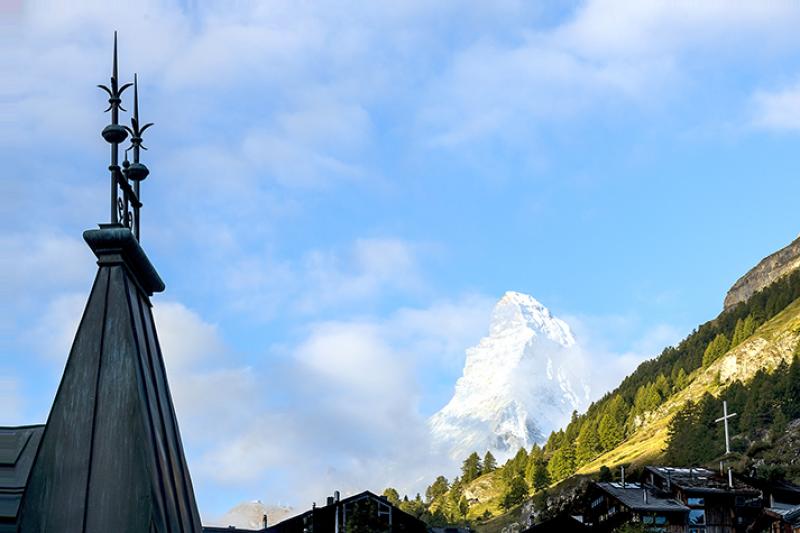Switzerland (plus Italy) in fall 2021
This item appears on page 12 of the January 2022 issue.
Flying from Denver to Zürich on Sept. 11, 2021, my husband and I spent 10 nights in Switzerland, then nine nights in Italy attending a photo workshop in the Dolomites before flying back to Zürich for an overnight (and COVID testing) prior to our flight home on Oct. 3.
Observance of COVID protocols was much stricter in Switzerland than in Italy.
In Switzerland, we weren’t allowed to eat or drink indoors without showing proof of vaccination. Proprietors told us they could be fined CHF10,000 (near $10,900) if they were caught violating this rule. Our CDC COVID vaccination cards from the US were accepted throughout the country.
Around Sept. 14, we were told that Switzerland had agreed to use the EU Digital COVID Certificate adopted by the European Union and that all Swiss citizens and visitors who wanted to apply for it had to prove their status. The wonderful managers of our hotel (Hotel Alpenblick) filled out our applications and emailed them for us, but on Sept. 20 we received an email from the Swiss government saying only Swiss citizens could apply.*
Fortunately, Swiss businesses continued to accept our proof of vaccination. We did have to show our passports or driver’s licenses to prove we were the owners of our cards.
In contrast, in Italy, our trip leader told the staff at both of our hotels that all members of our group had been vaccinated, which sufficed, and we were only asked for our vaccination cards by a few small businesses during our stay.
By the way, anyone vaccinated in Colorado may use a digitized documents app called myColorado that includes your driver’s license as well as a record of your COVID vaccinations. We used this often within Switzerland with no problems. We also used it at least once in Italy, at a small establishment where we bought some lunch.**
Over the years, we have often followed the advice of ITN contributors in planning our trips, but we’ve never followed a complete plan until this trip, when we used Emily Moore’s suggestions in her letter “Switzerland ‘on the level’” (Sept. ’19, pg. 26) to lay out our 11-day visit to that country.
Our trip was originally set for September 2020 but was rescheduled to 2021, so I had plenty of time to exchange emails with Emily, and she was tremendously helpful throughout the planning process. (I reached Emily, a fellow ITN subscriber, by having the magazine forward my email to her, but she wrote that it is perfectly OK for me to include her email address in this letter, adding, “I love to help people plan travel to Switzerland.” Emily can be reached at aemoore53@att.net.)
Emily coached me on when and how to buy the Swiss Travel Pass and offered other information, such as seat reservations are not needed on regular trains with a second-class ticket. (One thing she mentioned was that her experience on the Glacier Express was frustrating because she couldn’t move from her assigned seat to a window seat to take pictures; she said that, given a choice, she would take a regular train on the same route as the Glacier Express.)
I used Rick Steves’ “Looking Up European Train Schedules and Routes Online” from his website (www.ricksteves.com) to figure out our routes and train changes in advance, including platform numbers.
One thing that’s changed in the past two years is that you no longer validate your Swiss Travel Pass when you begin using it. You just specify your start date when you buy it online, and a QR code is generated, which the conductor scans.
All the online train schedules for Swiss trains had said you were required to wear an N-95 mask, and we found that masks were required, but the wearing of that specific type was not enforced. (Of course, there was usually a handful of people who avoided putting any mask on until the conductor entered the car.)
We did use Emily’s two recommended hotels in Switzerland: Hotel Alpenblick (Ägerten 1078A, Mürren; phone +41 33 855 13 27, www.alpenblick-muerren.ch) and Hotel Testa Grigia (Bahnhofstraße 21, Zürich; phone +41 27 966 79 00, testa-grigia.com/en).
Both were good, but Hotel Alpenblick in Mürren was a pure delight. We stayed there five nights. From our balcony, we had a direct view of the Eiger, a mountain famous with climbers.
From Lauterbrunnen station, access to Mürren is via cable car and a rather ancient train, with two cars only, running every 15 to 20 minutes throughout the day. Within the town, which is “pedestrians only,” you walk (except, for larger hotels, motorized carts will come to the train station for your luggage).
Combinations of lifts and trains throughout the area give access to all sorts of hiking opportunities. We again followed Emily’s advice and took the trails with the least elevation gains.
Emily’s recommendation to travel light is extremely valid, as we changed trains a lot. However, since we were doing a photo tour in Italy following the visit to Switzerland, we had to lug our camera gear throughout.
This trip was proof of what one ITN traveler’s experience can do for another. Thanks, Emily!
DONNA PYLE
Boulder, CO
*The EU Digital COVID Certificate is now available to US and Canadian travelers who will be spending at least one night in Switzerland. A traveler whose certificate is not approved will not be allowed to enter the country. To apply, visit www.covidcertificate-form.admin.ch/foreign.
**As reported in ITN (Dec. ’21, pgs. 4 & 27), digital COVID vaccine certificates from the US may be accepted by some business establishments in the European Union, but they have not been nationally approved, so American travelers will each need a physical CDC vaccination card for any border crossings in Europe.

